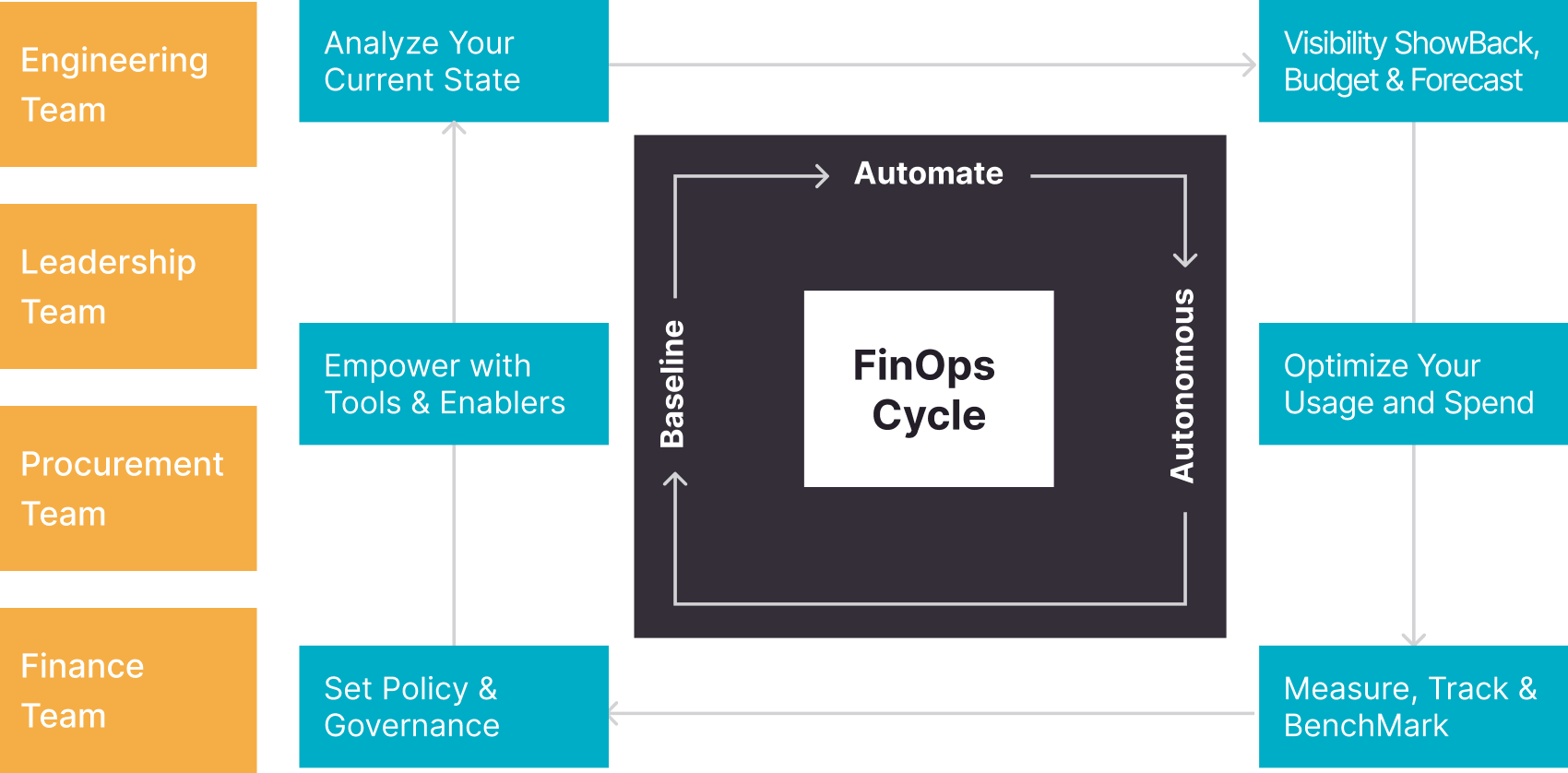Cloud spending will reach nearly $600 billion this year despite inflationary pressures. Escalating cloud costs offset business returns, especially against the backdrop of shrinking IT budgets and discretionary spending. Used to rampantly spinning-up cloud resources, enterprises now realize that pay-per-use is paying for what they deploy.
This is where the wastage becomes apparent: resources planned for spikes remain provisioned, whereas siloed operations lead to inconsistent procurement. The stocked-up reserved capacity remains unused in excess, and unmanaged carbon-dated and orphaned resources continue to incur storage costs. There is a need to discipline cloud operations to rein in these costs, or FinOps.
We propose that FinOps practices go beyond cost savings by helping enterprises bring in the much-needed sanity in their cloud operations. This blog outlines a FinOps framework demonstrating how enterprises can align business requirements with cloud deployments.
Why Cloud Costs Remain Clouded
As the hybrid cloud model gains traction, enterprises struggle to consolidate and allocate costs for projects deployed across multiple cloud service providers. This obfuscates their ability to distribute costs equitably, attribute tangible returns, and get granular insights into cost centers. The challenges are:
- Decentralized cloud infrastructure due to a multi-cloud setup
- Complicated cost-consumption mapping with cloud bills running into millions of line items
- Lack of standard pricing across providers, resulting in inaccurate forecasting and budgeting
- Inefficient cost tagging for shared infrastructure costs, such as containers
Seeing through with Three Cs of FinOps
An ideal FinOps strategy should focus on implementing best practices that deliver on business objectives, such as maximizing returns from IT investments while tapping into the agility, scalability, and cost elasticity the cloud promises. Successful FinOps strategies require breaking through organizational silos and aligning different stakeholders to a finance-oriented approach to the cloud.
Persistent’s FinOps mental model takes a 360-degree approach and pivots on three Cs: cost insights, consumption and optimization, and culture.
Cost Insights: For granular visibility into cloud expenditure, consider:
- Allocation: Identifying the cost owner in cloud billing can be quite challenging due to its complexity. Cost allocation is key in understanding resource usage, allowing for the identification of responsible teams, projects, or departments. Accurate labeling (tagging) and configuration can help monitor expenses and address anomalies.
- Unit Economics: Unit economics tie cloud services to business value. It is essential to map each unit to the cloud services it deploys and split the cost of shared infrastructure with utilization data. A thorough understanding of the cloud architecture and multiple datasets is crucial to gain insights into profitability and enable data-driven business decisions. Monitoring unit metrics to track cloud spending can help enterprises make informed decisions about cost-takeout measures.
- Budget & Forecast: Ensuring optimal usage and cost efficiency requires regularly reviewing and adjusting budgets, allocating funds for cloud components, and configuring alerts for budget overages. Defining thresholds can alert teams to any unexpected variance and make necessary adjustments. Powerful forecasting models can offer insights into variance, granularity, seasonality, and adaptivity to effectively plan and predict cloud expenses.
Consumption and Optimization: To identify suboptimal utilization, consider:
- Tracing and Optimizing Workloads: Even a highly optimized resource not contributing to business value can be a wasteful spend. A resource utilization matrix can help identify potential discrepancies and map workload demands. Persistent recommends optimizing resources based on a workload’s financial relevance and infrastructural requirements. This ensures cloud services are optimally utilized and tuned to maximize business value while minimizing wastage.
- Cloud Rate Optimization: It helps to reserve resources in advance and define pricing models based on forecasts to achieve better price performance. We recommend committing to resource-based and flexible resource-based commitment discounts for long-term savings. It is pertinent to note that underutilization or significant usage not covered by discounts can negatively impact the effective saving rate.
- Timely Decisions: There are resource usage monitoring tools available in the market that offer tailored reports to detect abrupt cost surges, cloud excess, and identify feasible opportunities for cost savings. This empowers stakeholders to take timely strategic calls on resource provisioning and budget-related decision-making, harmonizing organizational procedures with cloud operations to achieve cost and business efficiency.
Culture: Enable cross-functional teams share a common goal of optimizing cloud costs and work collaboratively to:
- Establish Cloud Cost Governance: Cloud cost management should be ongoing. Persistent’s cloud experts advise establishing clear cost policies and enforcing them in real-time to achieve effective Cloud FinOps.
- Outline Definitive Roles: Establishing a clear and well-defined accountable structure is essential for efficient FinOps management. Persistent suggests adopting FinOps Foundation’s RACI model to clarify roles, reporting lines, and responsibilities and to assign team members that are Responsible (R), Accountable (A), Consulted (C), or Informed (I) to layout decision-making authorities and relationships between teams.
- Adopt FinOps as a mindset: It is crucial to establish a culture of responsibility so that each team member understands their role in implementing and maintaining FinOps practices. This promotes ownership and accountability, increasing operational flexibility and cost awareness. By continuously refining and optimizing FinOps practices, organizations can remain agile and efficient in managing cloud costs.
Fig.1 – FinOps Alignment
Stop the Cloud Drainage with Persistent
Persistent can help enterprises cut cloud costs by 30-40%, depending on the baseline. Our next-generation multi-cloud intelligent operations framework, CloudOps, is the one-stop solution for cloud management challenges. With deeper cloud visibility, preventative governance guardrails, and automatic remediation, CloudOps ensures continuous compliance across multi-cloud environments, including AWS, Azure, Google Cloud, and Oracle Cloud.
Our cloud expertise has earned Persistent the rank of a Challenger in Gartner’s 2023 Magic Quadrant for Public Cloud IT Transformations. Our strategic partnerships with hyperscalers can make us the preferred cloud partner for enterprises, where our intimate understanding of billing structures and deeply embedded project pipelines help us secure meaningful discounts for our clients.
Kick-start your FinOps journey with Persistent. Visit here for more.







